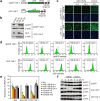Time-lapse imaging of microRNA activity reveals the kinetics of microRNA activation in single living cells
- PMID: 28974737
- PMCID: PMC5626736
- DOI: 10.1038/s41598-017-12879-2
Time-lapse imaging of microRNA activity reveals the kinetics of microRNA activation in single living cells
Abstract
MicroRNAs (miRNAs) are small, non-coding RNAs that play critical roles in the post-transcriptional regulation of gene expression. Although the molecular mechanisms of the biogenesis and activation of miRNA have been extensively studied, the details of their kinetics within individual living cells remain largely unknown. We developed a novel method for time-lapse imaging of the rapid dynamics of miRNA activity in living cells using destabilized fluorescent proteins (dsFPs). Real-time monitoring of dsFP-based miRNA sensors revealed the duration necessary for miRNA biogenesis to occur, from primary miRNA transcription to mature miRNA activation, at single-cell resolution. Mathematical modeling, which included the decay kinetics of the fluorescence of the miRNA sensors, demonstrated that miRNAs induce translational repression depending on their complementarity with targets. We also developed a dual-color imaging system, and demonstrated that miR-9-5p and miR-9-3p were produced and activated from a common hairpin precursor with similar kinetics, in single cells. Furthermore, a dsFP-based miR-132 sensor revealed the rapid kinetics of miR-132 activation in cortical neurons under physiological conditions. The timescale of miRNA biogenesis and activation is much shorter than the median half-lives of the proteome, suggesting that the degradation rates of miRNA target proteins are the dominant rate-limiting factors for miRNA-mediated gene silencing.
Conflict of interest statement
The authors declare that they have no competing interests.
Figures








Similar articles
-
Regulation of the MIR155 host gene in physiological and pathological processes.Gene. 2013 Dec 10;532(1):1-12. doi: 10.1016/j.gene.2012.12.009. Epub 2012 Dec 14. Gene. 2013. PMID: 23246696 Review.
-
MicroRNA profiling reveals dysregulated microRNAs and their target gene regulatory networks in cemento-ossifying fibroma.J Oral Pathol Med. 2018 Jan;47(1):78-85. doi: 10.1111/jop.12650. Epub 2017 Nov 1. J Oral Pathol Med. 2018. PMID: 29032608
-
The complexities of microRNA regulation: mirandering around the rules.Int J Biochem Cell Biol. 2010 Aug;42(8):1316-29. doi: 10.1016/j.biocel.2009.09.016. Epub 2009 Sep 30. Int J Biochem Cell Biol. 2010. PMID: 19800023 Review.
-
miR-10b-5p expression in Huntington's disease brain relates to age of onset and the extent of striatal involvement.BMC Med Genomics. 2015 Mar 1;8:10. doi: 10.1186/s12920-015-0083-3. BMC Med Genomics. 2015. PMID: 25889241 Free PMC article.
-
Dual regulation by microRNA-200b-3p and microRNA-200b-5p in the inhibition of epithelial-to-mesenchymal transition in triple-negative breast cancer.Oncotarget. 2015 Jun 30;6(18):16638-52. doi: 10.18632/oncotarget.3184. Oncotarget. 2015. PMID: 26062653 Free PMC article.
Cited by
-
Spatially specific mechanisms and functions of the plant circadian clock.Plant Physiol. 2022 Sep 28;190(2):938-951. doi: 10.1093/plphys/kiac236. Plant Physiol. 2022. PMID: 35640123 Free PMC article. Review.
-
Roles of microRNAs in Ovarian Cancer Tumorigenesis: Two Decades Later, What Have We Learned?Front Oncol. 2020 Jul 21;10:1084. doi: 10.3389/fonc.2020.01084. eCollection 2020. Front Oncol. 2020. PMID: 32850313 Free PMC article. Review.
-
mir-124-5p Regulates Phagocytosis of Human Macrophages by Targeting the Actin Cytoskeleton via the ARP2/3 Complex.Front Immunol. 2019 Oct 4;10:2210. doi: 10.3389/fimmu.2019.02210. eCollection 2019. Front Immunol. 2019. PMID: 31636629 Free PMC article.
-
Insights about circadian clock in glioma: From molecular pathways to therapeutic drugs.CNS Neurosci Ther. 2022 Dec;28(12):1930-1941. doi: 10.1111/cns.13966. Epub 2022 Sep 6. CNS Neurosci Ther. 2022. PMID: 36066207 Free PMC article. Review.
-
Differentially expressed miRNAs offer new perspective into cave adaptation of Astyanax mexicanus.Ann N Y Acad Sci. 2025 Apr;1546(1):173-181. doi: 10.1111/nyas.15300. Epub 2025 Mar 13. Ann N Y Acad Sci. 2025. PMID: 40082196 Free PMC article.
References
Publication types
MeSH terms
Substances
LinkOut - more resources
Full Text Sources
Other Literature Sources
Research Materials

